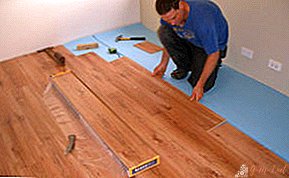Laminate flooring is a fairly common flooring option. We suggest paying attention to one of its subspecies - vinyl laminate. To choose which coating is better and what to focus on, let's compare these options by their characteristics.

What is a vinyl laminate
 This option is called a laminate only on the basis of appearance. In general, it cannot be called one of the subspecies, because the technology of their production, as well as the composition, varies significantly.
This option is called a laminate only on the basis of appearance. In general, it cannot be called one of the subspecies, because the technology of their production, as well as the composition, varies significantly.
So, a vinyl laminate is tiles or lamellas made on the basis of polyvinyl chloride. The vinyl floor consists of 3 layers:
- Base. It is made by polymerization of vinyl chloride. Also it includes various plasticizers and stabilizers.
- Upper. This is a paper layer on which a decorative pattern is applied.
- Protective. It consists of a thin film that protects the picture from abrasion and scratches.

The main differences from a conventional laminate
The main difference is the material used for the manufacture. The basis of the vinyl floor is PVC, the basis of the laminate is lumber.
Laminate board has more layers.
 The basis is HDF board made of pressed lumber.
The basis is HDF board made of pressed lumber.- Under the base there is a stabilizing layer of dense cardboard, which is responsible for noise and heat insulation.
- Next, a paper layer with a decorative pattern.
- The finish consists of melamine or acrylic resins. It protects the board from abrasion and damage, gives a glossy appearance.
So, the laminate can be considered a more environmentally friendly material.
Pros and cons of a conventional laminate
Knowing the main characteristics, we can derive the pros and cons of each material.
So, the positive qualities of the laminate are the following.
- Thickness. The minimum thickness of the laminate board is 4 mm, the chassis is 8 mm. While the vinyl laminate is 3 mm.
- Environmental friendliness. Looking at the components, as well as the method of production of the compared materials, we conclude that the laminate is more environmentally friendly.
- Life time. With proper use, the life of the laminate is higher than that of a vinyl board.
- Easy installation.

Of the minuses, we can distinguish:
- poor moisture tolerance;
- fire hazard (except for fireproof models);
- the difficulty of replacing individual slats;
- easily scratched, with improper load distribution, cracks appear between the lamellas.
Here are the general specifications. If we talk about wear resistance and life, these parameters depend on the nature of use and maintenance of the floor, as well as the class of the laminate.
Pros and cons of vinyl laminate
Among the advantages of a vinyl board, we distinguish:
- high moisture resistance;
- resistance to scratches;
- fire resistance;
- lack of the possibility of cracks.

By cons include:
- non-environmental friendliness;
- small thickness of the board;
- difficulty in installation.
What's better
The choice depends on the required characteristics. If the floor will be laid in a room with high humidity, as well as a high degree of operation, then it is worth choosing a vinyl laminate.

If the operating conditions are normal, and the floor is laid in the living room, it is worth choosing a laminate.
Important! The main condition under which both materials will last a long time is proper care.

 The basis is HDF board made of pressed lumber.
The basis is HDF board made of pressed lumber.
Leave Your Comment